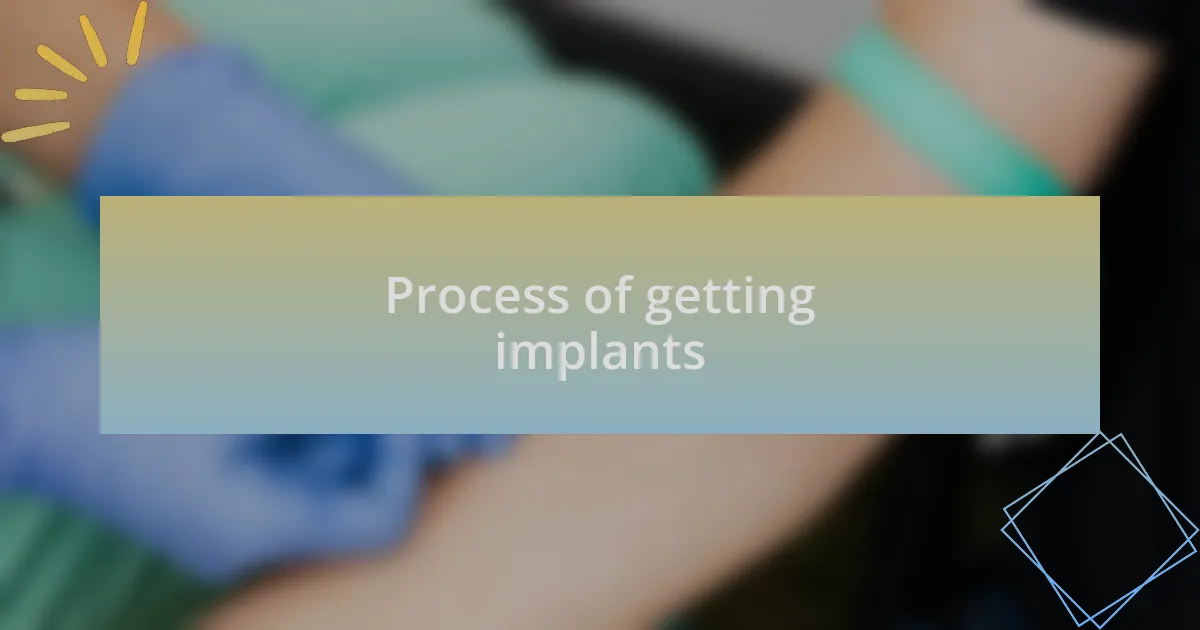Key takeaways:
- Dental implants serve as a durable and aesthetic solution for tooth loss, mimicking natural teeth and contributing to oral health by preventing bone loss.
- The process of getting implants involves thorough consultation, implant placement, healing, and attaching crowns, requiring patience and commitment.
- Common myths include beliefs that implants are only for older adults, are painful to receive, or require extra maintenance; in reality, they are suitable for a wide age range and involve regular dental care similar to natural teeth.
- Post-implant care is crucial, emphasizing optimal oral hygiene, avoiding hard foods during healing, and maintaining regular follow-up appointments with the dentist.

Understanding dental implants
Dental implants are an innovative solution for tooth loss, rooted in the idea of mimicking natural teeth. I remember the first time I learned about them; I was amazed at how a titanium post could serve as a sturdy foundation for a crown. Have you ever thought about how this technology might change someone’s life, giving them confidence and restoring their smile?
The process involves placing the implant into the jawbone, which then undergoes a process called osseointegration—essentially, the bone grows around the implant to hold it securely in place. I found it fascinating to see how this interaction not only provides support but also helps maintain the jawbone’s structure over time. Have you considered how important this aspect is for long-term oral health?
Understanding dental implants also means recognizing the commitment involved. From my experience, the process can take several months, including healing time. I often wondered if people fully grasp this timeline before jumping in. It’s crucial to weigh the permanence of this solution against your current lifestyle and expectations. How ready are you to embrace this significant change?

Benefits of dental implants
Dental implants offer a remarkable advantage by closely resembling the look and function of natural teeth. I recall a patient sharing how they felt an immense boost in self-esteem after getting their implants, transforming not just their smile but their entire outlook on life. It’s incredible to think that something as simple as a restored smile can empower someone to engage more confidently in social situations.
Another significant benefit is the durability of dental implants. Unlike traditional dentures, which can be uncomfortable or require frequent adjustments, implants can last many years with proper care. In my practice, I’ve seen patients regard their implants almost like a long-term investment in their health and happiness. Isn’t it reassuring to know that you’re opting for a solution that provides stability and reliability?
Additionally, dental implants contribute to better oral health overall. They help prevent bone loss that can occur with missing teeth, which is something I wish I had appreciated sooner in my own journey. Have you ever thought about how preserving your jawbone can impact not just your teeth, but your facial structure too? It’s a compelling reason to consider implants as more than just replacements; they are a crucial part of maintaining a balanced and healthy mouth.

Process of getting implants
The process of getting dental implants typically begins with a thorough consultation. I remember when a new patient came in, anxious yet hopeful. During this first meeting, I assessed their dental health and discussed their specific needs, which is crucial for customizing the best treatment plan. Have you ever considered how vital this initial step is in ensuring success? It sets the foundation for everything that follows.
Once we’ve confirmed the patient is a suitable candidate, the next phase involves placing the implant—the titanium post that will serve as the new tooth root. I still vividly recall one patient’s nervousness before the procedure; I reassured them that the process is often far less intimidating than it seems. After a few months of healing, during which the implant integrates with the bone, patients start to feel a sense of anticipation for their new smile.
Finally, after the healing period, we attach the crowns that will complete the restoration. This is a moment I cherish, witnessing the joy and relief on a patient’s face when they catch their reflection for the first time. It’s a transformative experience, marrying function with aesthetics in a way that reminds us all of the power of dentistry to change lives. Don’t you think that feeling of happiness makes the entire journey worthwhile?

Common myths about implants
Many people believe that dental implants are only for older adults. I remember when a young woman in her twenties visited my clinic, feeling uncertain because she thought implants were meant for seniors. The truth is, age isn’t necessarily a barrier; I’ve seen patients in their twenties to seventies benefit from implants, depending on their dental health and individual circumstances.
Another common myth I encounter is that the implant procedure is painful. I recall a patient who was visibly apprehensive, convinced that the discomfort would be unbearable. However, after the procedure, they were pleasantly surprised to report minimal pain, attributing it to modern techniques and anesthesia. This experience taught me that addressing fears upfront can genuinely change a patient’s outlook.
Some also believe that implants require extra maintenance compared to natural teeth. I had a patient who was under the impression they would need special tools to care for their implants. In reality, maintaining implants is similar to caring for regular teeth: a solid oral hygiene routine and regular dental visits are all it takes. Since I started sharing this simple truth, I’ve noticed a significant reduction in patient anxiety about maintenance, which is truly gratifying.

Personal experiences with implants
I remember my first experience guiding a patient through the dental implant journey. They came in with a mixture of hope and anxiety, unsure about what to expect. After the procedure, the joy on their face when they realized they could eat a crunchy apple again was priceless. It made me wish I had shared more about the procedure’s positive outcomes earlier.
In another instance, I worked with a patient who had dealt with dental issues for years, feeling embarrassed about their smile. When they finally decided to get implants, their transformation was astounding. They not only regained their confidence but also a sense of freedom in social situations. It’s moments like these that reinforce my belief in the transformative power of dental implants.
Reflecting on my experiences, it’s clear to me that understanding the emotional impact of implants is just as crucial as the physical aspects. Have I ever seen someone’s life change after getting implants? Absolutely. Each success story reaffirms the importance of knowledge and preparedness going into the process, showing that dental implants can truly reshape lives.

Post-implant care tips
Taking care of your dental implants is essential for their longevity and your overall oral health. After my own dental implant procedure, I quickly learned the importance of maintaining optimal oral hygiene. It’s not just about brushing; using a non-abrasive toothpaste and a soft-bristle toothbrush can make a significant difference, minimizing the risk of damaging the implant.
When I first had my implants, I found it crucial to follow post-operative instructions closely. This included avoiding hard or sticky foods during the initial healing period. I remember trying a piece of popcorn too soon and regretting it instantly—being patient really pays off! Listening to your dentist’s advice here is key to ensuring a smooth recovery.
One of the most valuable pieces of advice I can offer is to schedule regular follow-up appointments. These visits offer a chance for your dentist to monitor your implants and identify any potential issues early on. Just as I did, make sure you share any changes in your oral health; open communication helps in keeping everything in check.